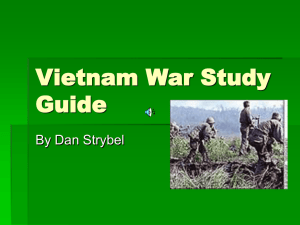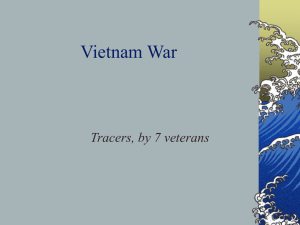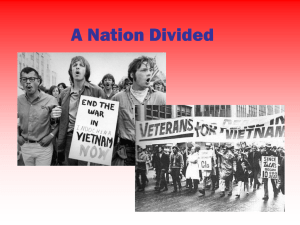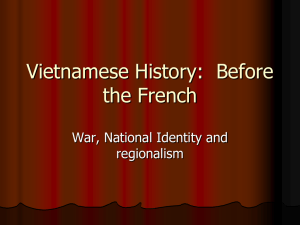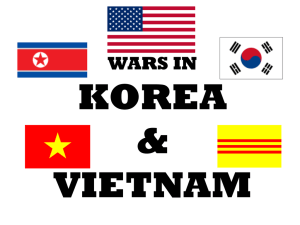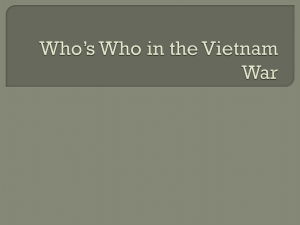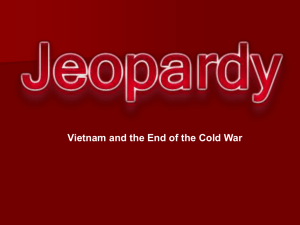Vietnam War Packet
advertisement
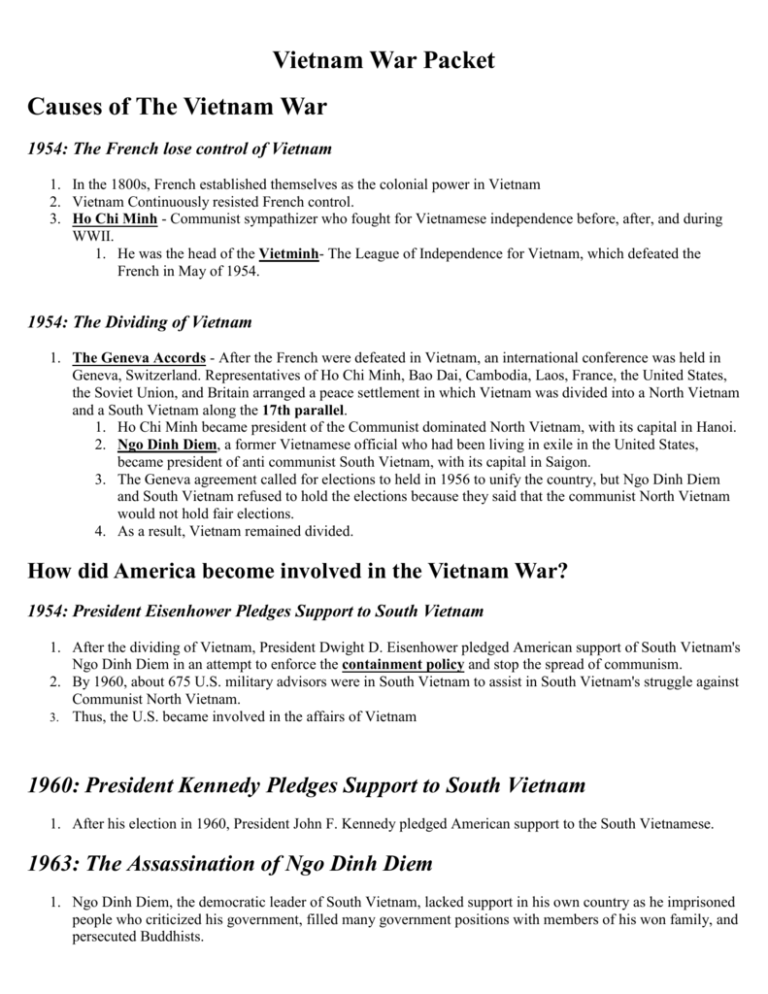
Vietnam War Packet Causes of The Vietnam War 1954: The French lose control of Vietnam 1. In the 1800s, French established themselves as the colonial power in Vietnam 2. Vietnam Continuously resisted French control. 3. Ho Chi Minh - Communist sympathizer who fought for Vietnamese independence before, after, and during WWII. 1. He was the head of the Vietminh- The League of Independence for Vietnam, which defeated the French in May of 1954. 1954: The Dividing of Vietnam 1. The Geneva Accords - After the French were defeated in Vietnam, an international conference was held in Geneva, Switzerland. Representatives of Ho Chi Minh, Bao Dai, Cambodia, Laos, France, the United States, the Soviet Union, and Britain arranged a peace settlement in which Vietnam was divided into a North Vietnam and a South Vietnam along the 17th parallel. 1. Ho Chi Minh became president of the Communist dominated North Vietnam, with its capital in Hanoi. 2. Ngo Dinh Diem, a former Vietnamese official who had been living in exile in the United States, became president of anti communist South Vietnam, with its capital in Saigon. 3. The Geneva agreement called for elections to held in 1956 to unify the country, but Ngo Dinh Diem and South Vietnam refused to hold the elections because they said that the communist North Vietnam would not hold fair elections. 4. As a result, Vietnam remained divided. How did America become involved in the Vietnam War? 1954: President Eisenhower Pledges Support to South Vietnam 1. After the dividing of Vietnam, President Dwight D. Eisenhower pledged American support of South Vietnam's Ngo Dinh Diem in an attempt to enforce the containment policy and stop the spread of communism. 2. By 1960, about 675 U.S. military advisors were in South Vietnam to assist in South Vietnam's struggle against Communist North Vietnam. 3. Thus, the U.S. became involved in the affairs of Vietnam 1960: President Kennedy Pledges Support to South Vietnam 1. After his election in 1960, President John F. Kennedy pledged American support to the South Vietnamese. 1963: The Assassination of Ngo Dinh Diem 1. Ngo Dinh Diem, the democratic leader of South Vietnam, lacked support in his own country as he imprisoned people who criticized his government, filled many government positions with members of his won family, and persecuted Buddhists. 2. As a result, Diem was assassinated in 1963. 3. With Ngo Dinh Diem no longer in control, the Vietcong, who were Communist guerilla fighters in the South gained control of more territory in South Vietnam and earned the loyalty of an increasing number of the South Vietnamese people. 4. Ho Chi Minh and the North Vietnamese aided the Vietcong throughout. Buddhist monk burning himself in the streets of Saigon in protest of Ngo Dinh Diem, 1963. Source: http://media.photobucket.com/image/burning%20monk/wtsang07/vietnamwarmonk.jpg 1964: The Gulf of Tonkin Incident and Gulf of Tonkin Resolution 1. After Kennedy's assassination in 1963, Lyndon B. Johnson became President and, like Kennedy, he was determined to carry out the Containment policy and stop the spread of communism by supporting South Vietnam. 2. Gulf of Tonkin Incident - Statement issued by Johnson in 1964 in which he said U.S. destroyer ships had been sunk by North Vietnamese torpedoes in the Gulf of Tonkin, a body of water located 30 miles off the coast of Vietnam. 1. The attack was made up and not true, but it deepened U.S. interest in the war. 3. Gulf of Tonkin Resolution - Gave Johnson the authority to "take all necessary measures to repel any armed attack against the forces of the United States and to prevent further aggression." 1. The Gulf of Tonkin Resolution basically gave Johnson complete control over what the U.S. did in Vietnam. 1964: President Johnson increases aid to South Vietnam 1. After winning the election of 1964, President Johnson began a gradual escalation of the Vietnam war effort. 2. Johnson provided more troops and money to South Vietnam to fight the Vietcong. 3. At the beginning of 1965, American troops in South Vietnam numbered 25,000. By the end of 1965, American troops in South Vietnam numbered 184,000. 4. By the end of 1968, more than 536,000 American troops were in Vietnam. Fighting in Vietnam General Conditions 1. Nearly 3 million U.S. Soldiers served in Vietnam. 2. Conditions were unlike any U.S. soldiers had ever seen as they battled elephant grass, rain storms, bugs, and constant guerilla warfare. 3. The Vietcong were familiar with the swamps and jungles, and they had the support of much of the South Vietnamese population. The Ground War 1. Guerrilla Warfare tactics were used by the Vietcong. 2. The Vietcong had elaborate underground tunnels and various booby traps. 3. Booby traps posed constant hazards for American soldiers. 1. Land mine - and explosive device planted in the ground. 2. Punji Trap - a camouflaged pit filled with razor-sharp stakes that were sometimes poisoned. The Air War 1. The United States used B-52 Bombers to launch drop thousands of tons of explosives over large areas and smash roads and bridges. 1. Saturation Bombing - The U.S. practice of dropping massive amounts of explosives over Vietnam in an attempt to destroy key roads and bridges. 2. Fragmentation Bombs - Bombs used in air raids that threw pieces of their thick metal casing in all directions when they exploded. 3. Napalm - Jelly like substance used in bombing raids that burned continually and uncontrollably. 2. The United States also used chemical weapons against the Vietnamese. 1. Agent Orange - Herbicide dropped on dense jungle. By killing the leaves and thick undergrowth, the herbicide exposed Vietcong hiding places. Agent orange also killed crops and it was later discovered that Agent Orange caused health problems in livestock, civilians, and soldiers. Ho Chi Minh Trail 1. The Ho Chi Minh Trail was a supply route that passed through Laos and Cambodia. 1. The Ho Chi Minh Trail allowed the Vietcong to gain strength by gaining troops and supplies from North Vietnam 1968: The Tet Offensive 1. The Tet Offensive was a major offensive launched by the North Vietnamese and Vietcong in 1968 1. The Tet Offensive included surprise attacks on major cities, towns, and American military bases throughout South Vietnam. 2. The Communist forces were extremely brutal during the Tet Offensive as they slaughtered anyone they labeled an enemy, including minor officials, teachers, and doctors. 2. Although the Tet Offensive was turned back, it was a major psychological victory for the North Vietnamese and the Vietcong and a major psychological setback for the U.S. 3. The Tet Offensive was the turning point in the Vietnam War because it illustrated that the North Vietnamese and the Vietcong were capable of launching a major offensive. 4. As images from the Tet Offensive made their way to American televisions, both President Johnson and the war effort lost popularity and support. Vietnam War Protest Background 1. Throughout the 1960s and 1970s, many Americans protested the United States' involvement in the Vietnam War because they felt America had no business getting involved in the conflict between North and South Vietnam. 2. As American casualties rose throughout the Vietnam War, anti-war demonstrations in the U.S. intensified and became more frequent. 3. Vietnam War protests came in many forms in the United States. Musical Protests 1. During the Vietnam War, many musicians used their music as an avenue to express their anti-Vietnam War sentiments. 2. Some of the most famous artists and groups to protest the Vietnam War through their music included Creedence Clearwater Revival, Buffalo Springfield, The Beatles, Bruce Springsteen, and Neil Young. Teach-Ins 1. Teach-Ins took place on college campuses throughout the U.S. during the 1960s as antiwar activists met to discuss the Vietnam War. 2. Many of the people who participated in these sit-ins felt that the Vietnam Conflict was a civil war that should be solved by the Vietnamese people alone. Therefore, antiwar protestors continually questioned why America was involved in the war. 3. Click the link below or google to watch the video and listen to Buffalo Springfield's "For What It's Worth." 1. As you listen, consider the following questions: What does this song teach us about the Vietnam war? Is it prowar or antiwar? Explain. 2. Buffalo Springfield "For What it's Worth." http://www.youtube.com/watch?v=f5M_Ttstbgs Draft Resistance 1. In the second half of the 1960s, many antiwar Americans started resisting the draft. 2. Most people who resisted were conscientious objectors, meaning they opposed fighting in the war on moral or religious grounds. 3. One major point of confrontation for people who resisted the draft was that college students could receive a deferment, or an official postponement of their call to serve. 1. Meant that those who could not afford to go to college did not have this avenue open to them. 2. Watch the video of Creedence Clearwater Revival's "Fortunate Son" and consider the following questions: "What does this song teach us about the Vietnam War and draft? Is it prowar or antiwar? Explain Response to Resistance 1. In several instances, Vietnam War Protests ended in violence. 2. Kent State Massacre - 1970, 4 students killed, 9 students wounded at Kent State University in Ohio when U.S. Army soldiers fired their weapons into a group of protesting student 3. Listen to Neil Young's song "Ohio" written about Kent State Massacre and consider the following questions: What does this song teach us about the Vietnam war and how Americans felt about the war? Is it pro-war or anti-war The Result of the Vietnam War 1968 - 1973: Paris Peace Talks 1. The Paris Peace Talks began in 1968 and were part of a peace negotiation effort started by President Johnson that last until 1972. 2. In January 1973, peace finally arrived when the United States, the Soviet Union, the North Vietnamese, and Vietcong signed a formal agreement with the following provisions: 1. The U.S. would withdraw forces from Vietnam with 60 days. 2. All prisoners of war would be released. 3. All military activity in Laos and Cambodia would end. 4. The 17th parallel would continue to divide North and South Vietnam until the country could be united. 3. Vietnamization was President Richard Nixon's plan to withdraw American forces from Vietnam and replace them with South Vietnamese forces that would be strong enough to defend their own freedom. 1975: The Fall of South Vietnam 1. American involvement in the Vietnam war ended in 1973, but the fighting in Vietnam continued. 2. Without American troops involved, the North Vietnamese launched a major campaign on South Vietnam. 3. In 1975, North Vietnamese Communist forces captured the South Vietnamese capital of Saigon, officially ending the war and uniting Vietnam under a single communist regime. 4. Neighboring countries Laos and Cambodia fell to communism shortly after. Newspaper headlines following the fall of Saigon and defeat of South Vietnam, 1975. Source: http://turningpoints.wikispaces.com/file/view/usnp003.jpg American Losses in the Vietnam War 1. 2. 3. 4. 58,000 Americans killed. 300,000 Americans wounded. 2,500 Americans listed as either prisoners of war or missing in action. Vietnam was the longest and most unsuccessful war in U.S. history. Vietnam War Worksheet Directions: Use the Vietnam packet of information to answer the following questions. Questions 14 – 16 require you to research and listen to 1960s video/songs. 1. 2. 3. 4. 5. 6. 7. Identify and explain at least two causes of the Vietnam War. Who was Ho Chi Minh? What were the Geneva Accords? How did the containment policy draw the U.S. into the Vietnam War? What type of regime did Ngo Dinh Diem have in South Vietnam? Explain the Gulf of Tonkin Incident and the Gulf of Tonkin Resolution. Which U.S. President significantly increased the amount of U.S. troops in Vietnam during the last half of the 1960s? 8. Who were the Vietcong? 9. What were fighting conditions like in Vietnam? Be specific. Give at least 3 examples. 10. What was the Ho Chi Minh Trail? 11. What was the Tet Offensive? 12. What was the significance of the Tet Offensive? 13. Identify and explain at least 3 different forms of protest that took place during the Vietnam War? 14. What does Buffalo Springfield’s “For What It’s Worth” teach us about the Vietnam War? Is the song pro-war or anti-war? Explain. 15. What does Creedence Clearwater Revival’s “Fortunate Son” teach us about the Vietnam War? Is the song pro-war or anti-war? Explain. 16. What does Neil Young’s “Ohio” teach us about the Vietnam War? Is the song pro-war or anti-war? Explain. 17. Describe what took place at the Kent State Massacre. 18. What were the Paris Peace Talks? 19. What was Vietnamization? 20. How did the war end for the United States? 21. What eventually happened to South Vietnam?
![vietnam[1].](http://s2.studylib.net/store/data/005329784_1-42b2e9fc4f7c73463c31fd4de82c4fa3-300x300.png)
